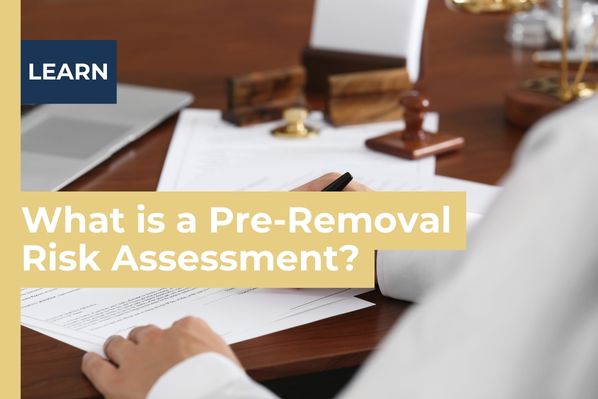If you face deportation from Canada, you may qualify for a Pre-Removal Risk Assessment (PRRA). The PRRA constitutes the ultimate risk evaluation provided to individuals before they depart from Canada.
This assessment serves as a crucial avenue for seeking protection by explaining the possible dangers or risks you encounter upon removal from Canadian territory.
Why is a Pre-Removal Risk Assessment issued?
If the Canada Border Services Agency (CBSA) has issued a Pre-Removal Risk Assessment (PRRA) to you, it indicates a high likelihood that you are currently confronting the prospect of deportation from Canada.
PRRA invitations are extended to individuals facing imminent removal from Canada. This indicates that you have received either an exclusion or deportation order. Before being deported from Canada, you are granted an opportunity to undergo a risk assessment. Consider it as a paper-based refugee application process.
Pre-Removal Risk Assessment Eligibility
PRRA Eligibility Criteria:
Generally, the application for a Pre-Removal Risk Assessment in Canada is only allowed if the Canada Border Services Agency (CBSA) has formally notified you of eligibility through a Notification Regarding a Pre-Removal Risk Assessment (PRRA Notification), often at an in-person meeting.
Individuals, except those specified below, can apply for a PRRA if they have an active removal order and have received the PRRA Notification from the CBSA.
Ineligibility for PRRA Application:
You are not eligible to apply for a PRRA if:
- Your refugee claim was deemed ineligible for referral to the Immigration Refugee Board of Canada (IRB) due to arriving in Canada from a safe third country.
- Another country has granted you convention refugee status, and you can return there.
- You already hold protected person status, indicating existing refugee protection in Canada.
- You are currently under extradition proceedings.
Restrictions for Previous Applicants:
If you previously had a rejected, abandoned, or withdrawn refugee claim or PRRA application, a new PRRA application is prohibited until at least 12 months.
Individuals from a “designated country” must wait at least 36 months before reapplying, a period known as the PRRA Bar.
Pre-Removal Risk Assessment Application
Application Process:
- To initiate the Pre-Removal Risk Assessment (PRRA) process, completing the application for a Pre-Removal Risk Assessment form (IMM 5508) is mandatory. Submit the filled form to the Citizenship and Immigration Canada PRRA Unit, CIC backlog reduction office, at the address specified in your notification, or through an electronic portal.
- All family members in Canada seeking a PRRA must individually fill out their application forms.
Supplementary Submissions:
- In association with the PRRA application form, you can submit written statements and provide supporting documentary evidence for your case.
- Written submissions serve as an avenue for you to narrate your circumstances and present your story. These submissions offer an opportunity to express the reasons and manner in which you anticipate being in danger or at risk of removal from Canada to your country of nationality or former residence.
- If you have previously had a rejected, abandoned, or withdrawn refugee claim or PRRA application, new evidence only can be provided to support your case. This refers to presenting evidence that emerged after the rejection, was not readily available, or could not reasonably have been expected to be presented during the initial rejection process.
Pre-Removal Risk Assessment Process
1. Procedure
- After issuance of a PRRA Notification, a period of 15 days is granted for the application form’s submission, with an additional 15 days allocated for providing written supporting submissions and evidence.
- Notification is conducted in person by a CBSA removals officer who provides a PRRA application kit. In cases of mail notification, an extra seven days are provided for application submission. Specific deadlines and designated addresses are outlined in the PRRA Notification package.
2. Evaluation
- The assessment of a PRRA application primarily considers the application itself, written submissions, and any accompanying supporting evidence. However, the possibility of being summoned for a hearing exists to address specific aspects of the application. In such cases, a written notice is issued specifying the time, date, and location. It matters to be discussed during the hearing.
3. Suspension of Removal Order
After receiving a PRRA notification, a regulatory stay of removal is imposed on the individual, suspending the removal order. This suspension remains in force until:
- Notification to IRCC indicating the intention not to apply for a PRRA in Canada;
- Exceeding the application deadline; or
- Rejection of the application (or voluntary withdrawal or abandonment).
What Happens if PRRA is Rejected?
- If your PRRA application is rejected, you must leave Canada.
- Another option is to apply for a judicial review from the Federal Court of Canada. However, departure from Canada remains compulsory unless an appeal for a “temporary stay of removal” is presented to the Federal Court.
Conclusion
Chaudhary Law Office can assist you in successfully navigating the complexities of the PRRA procedure. Our immigration lawyers in Canada possess in-depth knowledge of immigration laws and regulations. Our legal experts will construct a compelling case by gathering relevant documents and ensuring all necessary evidence is presented before the court proceedings.
Contact us at 416-447-6118 for personalized guidance and support in your PRRA proceedings.
FAQs
How to apply for pre-removal risk assessment?
Applying for PRRA involves completing the application form, gathering supporting documents, and presenting a compelling narrative outlining potential risks. Seek guidance from our experienced immigration lawyers for a smooth application process.
Is there a fee for pre-removal risk assessment?
No there is no fee associated with PRRA applications.
How long does pre-removal risk assessment take?
The processing time for pre-removal risk assessment can vary. Factors such as the complexity of the case, whether you are detained, and the workload of immigration authorities contribute to the timeline.

